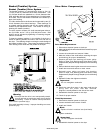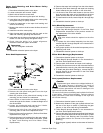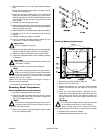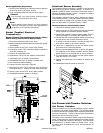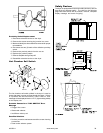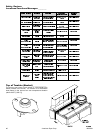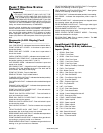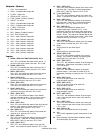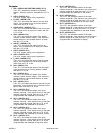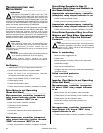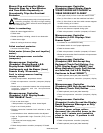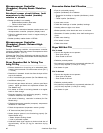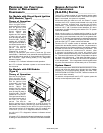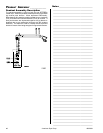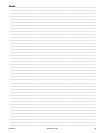
450260-1 www.amdry.com 47
PROCEDURE FOR FUNCTIONAL
CHECK OF REPLACEMENT
COMPONENTS __________________
For Models with Direct Spark Ignition
(DSI) Module (Type I) ________________
Theory of Operation:
Start the drying cycle.
When the gas burner
ignites within the chosen
trial for ignition time
(6-seconds), the flame
sensor detects gas
burner flame and
signals the DSI module
to keep the gas valve
open as long as there is
a call for heat. The DSI
module will LOCKOUT
if the gas burner flame is
not sensed at the end of
the trial for ignition
period. The trial for
ignition period will be
repeated for a total of
three (3) retries/trials (the initial try and two [2] more
retries/trials). If the flame is not sensed at the end of the third
retry/trial (inter-purge period of 30-seconds) the DSI module
will LOCKOUT (light emitting diode [L.E.D.] diagnostic
indicator flashes).
A steady L.E.D. indicator indicates normal operation.
No L.E.D. indicator indicates a power or an internal failure
has occurred.
For Models with DSI Module
(Type II) ______________________________
Theory of Operation:
Start the drying cycle.
When the gas burner
ignites within the chosen
trial for ignition time
(8-seconds), the flame
sensor detects gas
burner flame and
signals the DSI module
to keep the gas valve
open as long as there is
a call for heat. The DSI
module will LOCK OUT
if the gas burner flame is
not sensed at the end of
the trial for ignition
period. The trial for
ignition period will be repeated for a total of three (3)
retries/trials (the initial try and two [2] more retries/trials). If
the flame is not sensed at the end of the third retry/trial
(inter-purge period of 30-seconds), the DSI module will
LOCK OUT (a red L.E.D. diagnostic indicator will flash).
An unlit red L.E.D. diagnostic indicator indicates normal
operation.
A lit green L.E.D. diagnostic indicator indicates dryer controller
is calling for heat and that ALL interlocks have been satisfied.
SENSOR ACTIVATED FIRE
EXTINGUISHING
(S.A.F.E.) SYSTEM _____________
The S.A.F.E. system consists of a temperature probe, water
pressure switch, and a solenoid valve. Once 40 to 100 psi of
water is connected, the system is activated.
20-seconds after the heat turns off, the Phase 7 control
monitors the S.A.F.E. system probe located in the top of the
basket (tumbler) chamber and records the minimum
temperature. If the minimum recorded temperature is no
less than 120° F (48° C) and the control detects a 35° rise in
temperature, this will be the trip point and the S.A.F.E. system
routine will activate.
While a drying cycle is in process and the heat is on, the
Phase 7 control monitors the exhaust temperature transducer.
If the drying cycle temperature set point is set greater than
160° F (71° C) and the control detects an exhaust temperature
rise 25° F (-3.8° C) greater than set point, this will be the trip
point and the S.A.F.E. system routine will activate.
Once the S.A.F.E. system routine is activated, water will be
injected into the basket (tumbler) chamber. Anytime water is
being injected into the basket (tumbler); the basket (tumbler)
drive will turn the load for 1-second every 15-seconds. This
process will continue for a minimum of 3 minutes. After
3 minutes has elapsed, the control will check if the
temperature remained above trip point, if so water will remain
on. The control will continue to check if temperature is above
trip point every 30-seconds. If the water has been on for a
constant 10 minutes, the water will be turned off regardless
of the temperature. If the temperature has dropped below
trip point, the control will turn off the water prior to 10 minutes.
System Reset ________________________
After the microprocessor determines that the situation is under
control and shuts the water being injected into the basket
(tumbler) off, the microprocessor display will read FIRE
SUPPRESSION SYSTEM ACTIVATED, and the horn/tone will
sound until reset manually.
To reset the microprocessor and S.A.F.E. system, press the
red key on the keyboard (touch pad).



